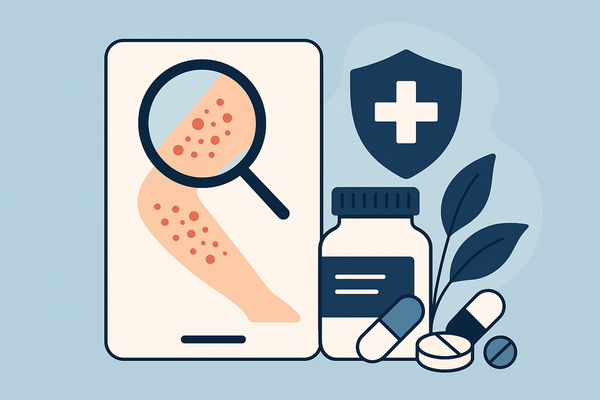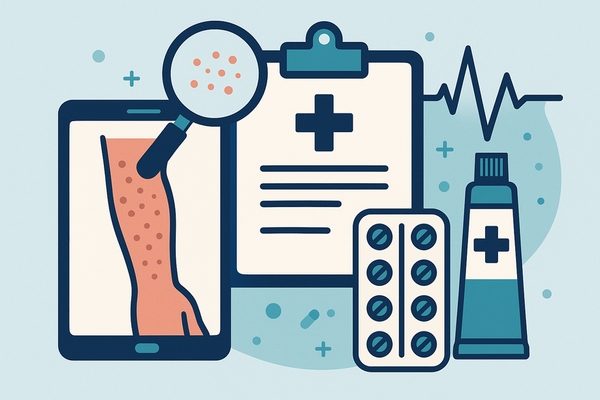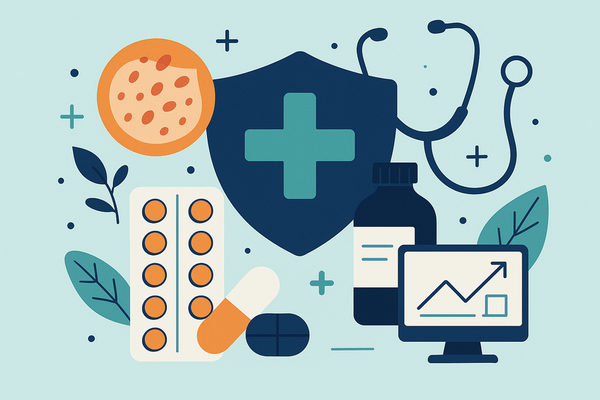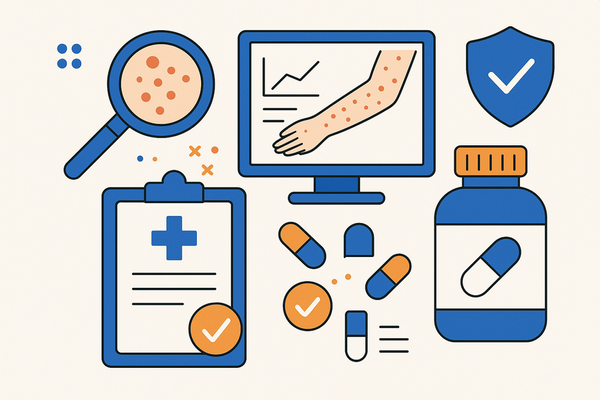Medication Rash Treatment: A Comprehensive Guide
Learn how to identify and manage medication-induced rashes to ensure safe drug use. Discover effective treatments and prevention strategies.
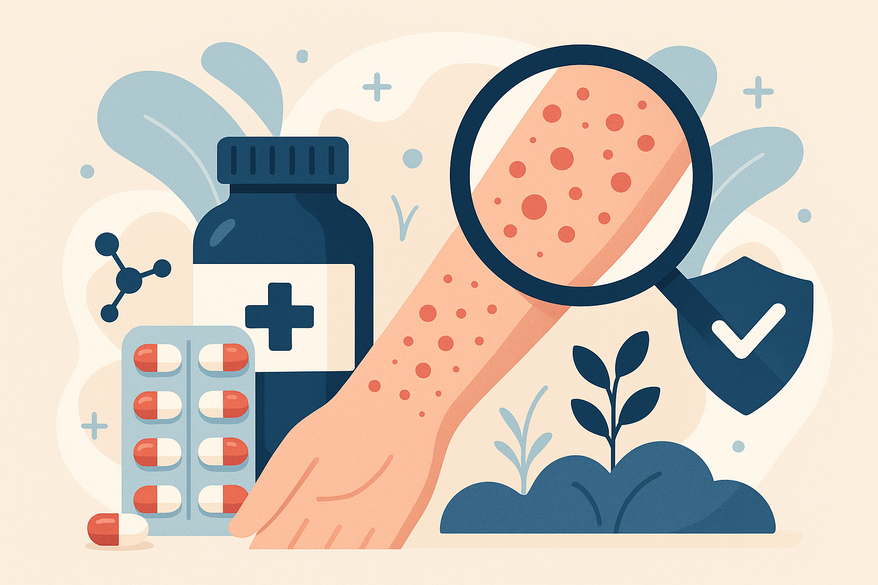
Estimated reading time: 10 minutes
Key Takeaways
- Medication-induced rashes range from mild itching to life-threatening reactions like Stevens-Johnson Syndrome.
- Early recognition relies on noting rash characteristics: color, distribution, and associated symptoms.
- Diagnostic process includes history, physical exam, lab tests, and possibly allergy testing.
- Treatment focuses on stopping the offending drug, symptomatic relief, and replacement therapies.
- Prevention and follow-up involve dose management, pre-screening, patient education, and ongoing monitoring.
Table of Contents
- Understanding Medication-Induced Rashes
- Recognizing the Signs and Symptoms of a Medication Rash
- The Diagnostic Process for Drug Allergies
- Treatment Options for Medication Rash
- Consultation and Follow-Up for Medication Rash Treatment
- Preventive Measures and Tips for Medication Rash Treatment
- FAQ
Understanding Medication-Induced Rashes
Medication rash treatment starts with learning about medication-induced rashes. A medication-induced rash is an adverse dermatologic response to a drug. It can range from mild redness and itching to life-threatening conditions such as Stevens-Johnson Syndrome (SJS). These rashes occur by two main mechanisms:
- Immunologic reactions: The body’s immune system sees the drug as an invader, leading to histamine release or T-cell–mediated delayed reactions.
- Non-immunologic reactions: The drug directly irritates skin cells or causes chemical changes in the skin.
| Type of Rash | Symptoms | Causative Drugs |
|---|---|---|
| Acneiform eruptions | Small red bumps, sometimes pus-filled | Anabolic steroids, corticosteroids |
| Fixed drug eruption | Single or multiple round, itchy dark red or purple spots | Sulfa antibiotics, tetracyclines |
| Urticaria (hives) | Itchy wheals that appear and disappear quickly | Aspirin, penicillins |
| Morbilliform rash | Flat and raised red bumps, often starting on the trunk | Sulfa drugs, ampicillin, NSAIDs |
| Purpura | Purple or red spots that do not fade under pressure | Blood thinners, certain diuretics |
| Stevens-Johnson Syndrome (SJS) | Blisters, painful red areas, skin detachment with mucosal involvement | Sulfa drugs, NSAIDs, antiepileptics |
For more details on spotting early drug-related rashes.
- AAD: Drug Allergy
- Mayo Clinic: Drug Reactions
- Cleveland Clinic: Drug Allergy
- NCBI: Medication-Induced Skin Reactions Study
Recognizing the Signs and Symptoms of a Medication Rash
Medication rash treatment relies on early recognition of signs and symptoms. You may see two types of reactions:
Immediate Reactions (minutes to hours)
- Hives – red, raised welts that can move around your body
- Itching – sudden, intense urge to scratch
- Wheals – round or ring-shaped swellings
Delayed Reactions (days to weeks)
- Maculopapular rash – red flat spots and raised bumps, often on the trunk and limbs
- Spreading pattern – rash that moves from chest to arms and legs over several days
Key characteristics to note:
- Color – red, purple, or dark patches
- Distribution – where the rash appears on the body
- Pruritus (itch) – mild to severe
- Pain or burning – indicates deeper skin involvement
Red-flag signs requiring urgent care:
- Difficulty breathing or wheezing
- Swollen lips, face, or eyelids
- High fever above 100.4°F (38°C)
- Blisters or peeling skin on more than 10% of body surface
- Mucosal involvement (eyes, mouth, genitals)
The Diagnostic Process for Drug Allergies
A clear diagnostic process is key to safe medication rash treatment decision-making. Here’s what to expect when you see a specialist:
- Detailed Medical History
- Onset timing: When did the rash start after taking the drug?
- Medication list: Include all prescriptions, over-the-counter pills, and herbal supplements.
- Physical Examination
- Morphology: Size, shape, and type of lesions (macules, papules, wheals).
- Distribution: Which body parts are affected?
- Mucosal check: Look at eyes, mouth, and genital areas.
- Laboratory Tests
- CBC with differential: Checks for high eosinophils if systemic signs (fever, joint pain).
- Liver and kidney panels: Rule out organ involvement in severe reactions.
- Allergy Testing
- Skin prick test: Small droplet of suspected drug on the skin, lightly pricked.
- Patch test: Drug applied under a patch and checked after 48–72 hours for delayed reactions.
- Drug De-challenge and Re-challenge
- De-challenge: Stop the suspect drug and see if the rash subsides.
- Re-challenge: Under strict medical supervision, reintroduce the drug to confirm the cause (only used if benefits outweigh risks).
What to expect in a dermatology or allergy consult:
- Duration: 30–60 minutes for history, exam, and testing plan.
- Safety measures: Emergency equipment on hand for severe reactions.
- Follow-up: Clear instructions on when to report new or worsening symptoms.
Beyond clinical tests, you can use AI tools like Rash Detector for an instant overview of your rash profile based on uploaded images.
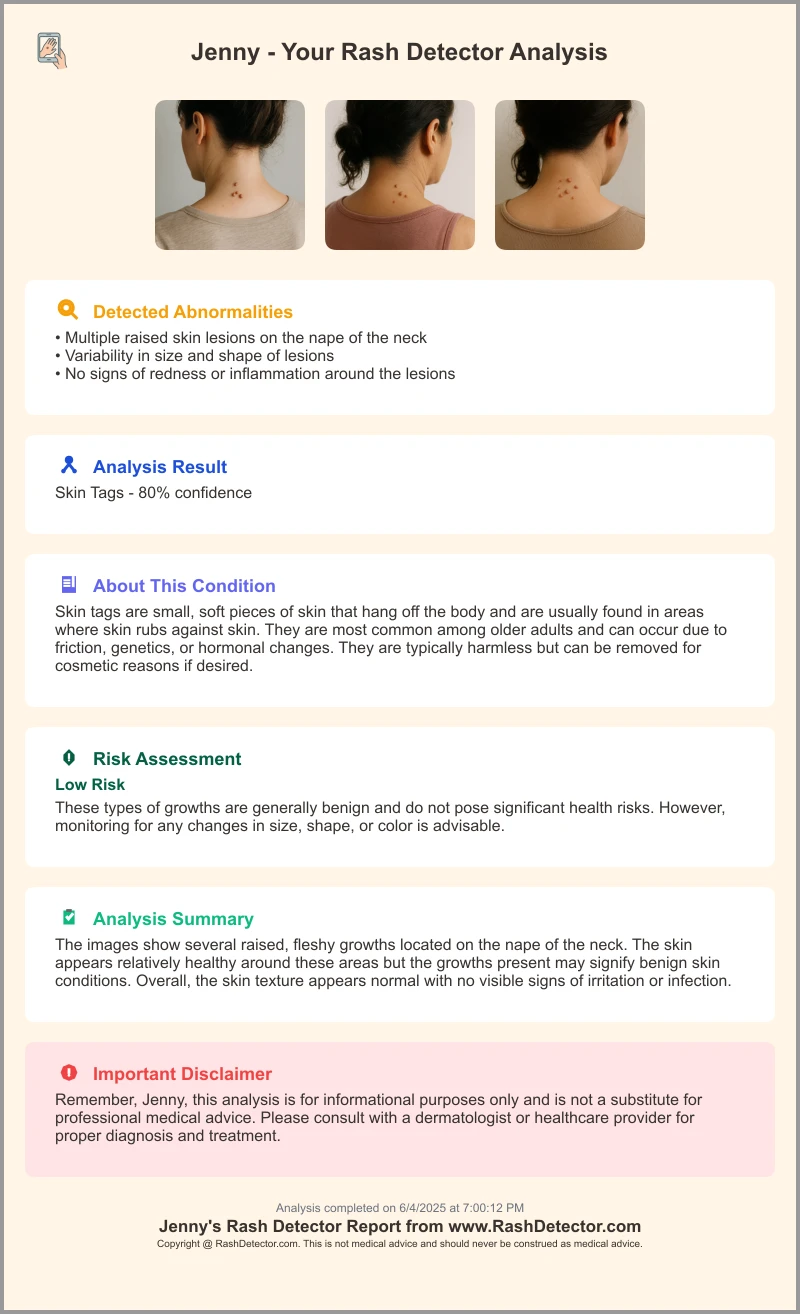
Treatment Options for Medication Rash
Medication rash treatment includes stopping the offending drug and easing discomfort.
Discontinuation and Substitution
- Immediately stop the suspected medication and inform your prescriber.
- Substitute with an alternative class if possible (e.g., switch penicillin to a macrolide antibiotic).
Symptomatic Relief Strategies
Over-the-Counter (OTC) Options
- Oral antihistamines such as diphenhydramine 25 mg every 6 hours for itching.
- Topical 1% hydrocortisone cream applied to small rash areas twice daily.
Prescription Therapies
- Systemic corticosteroids: Prednisone taper over 7–14 days for severe or widespread reactions.
- Epinephrine auto-injector: For anaphylaxis or life-threatening allergic responses.
Home Remedies and Supportive Care
- Cool compresses: Apply a damp, cool cloth to soothe the skin.
- Oatmeal baths: Use colloidal oatmeal to reduce inflammation and itch.
- Loose cotton clothing: Wear soft, breathable fabrics to minimize friction.
For guidance on long-term management and allergy prevention strategies.
Consultation and Follow-Up for Medication Rash Treatment
Consult a healthcare professional before making any changes to your medication regimen. Here are key questions to ask:
- “What alternative medications are available?”
- “What signs indicate a life-threatening reaction?”
- “Should I carry an epinephrine auto-injector?”
- “How do we document this allergy in my health record?”
Scheduling Follow-Up Visits
- First follow-up: Within 1 week after rash onset to monitor resolution.
- Additional labs: CBC or organ panels if systemic symptoms were present.
- Ongoing check-ins: As advised by your healthcare team to ensure full recovery.
Preventive Measures and Tips for Medication Rash Treatment
Use these best practices to reduce the risk of a drug-induced rash:
- Gradual dose escalation: Slowly increase dose under medical supervision when starting high-risk drugs.
- Pre-treatment allergy screening: Test for known drug sensitivities before use of sulfa drugs or penicillins.
- Updated medication list: Keep a current list of all prescriptions, OTC drugs, and allergies.
Monitoring Plan
- Check skin daily for the first 7–14 days after beginning a new medication.
- Take photos of any new rash and share with your clinician via telehealth if possible.
Patient Education
- Report any new rash immediately by phone, telehealth, or clinic visit.
- Carry an allergy card or use a medical ID app to record drug sensitivities.
Identifying, diagnosing, and managing medication-induced rashes requires clear steps: stop the drug, ease symptoms, follow up, and prevent future reactions. Prompt, informed action improves outcomes and lowers the risk of serious complications. Stay in close communication with your healthcare team for optimal medication rash treatment.
FAQ
How can I tell if a rash is caused by medication?
Look for timing (minutes to weeks after starting the drug), rash characteristics (color, distribution), and accompanying symptoms like fever or itch. A healthcare professional can confirm with tests.
When should I seek emergency care for a drug rash?
Seek urgent care if you experience difficulty breathing, swelling of the face or lips, high fever, widespread blisters, or mucosal involvement.
Can I ever restart a medication that caused a rash?
In some cases, under strict medical supervision, a drug re-challenge may be performed if the benefits outweigh the risks. This is only done in a controlled setting.
What over-the-counter treatments help with rash relief?
Oral antihistamines and topical hydrocortisone creams can reduce itching and inflammation. Cool compresses and oatmeal baths also provide relief.
How can future medication rashes be prevented?
Maintain an updated allergy list, perform pre-treatment screening for high-risk drugs, escalate dosing gradually, and monitor the skin closely when starting new medications.


